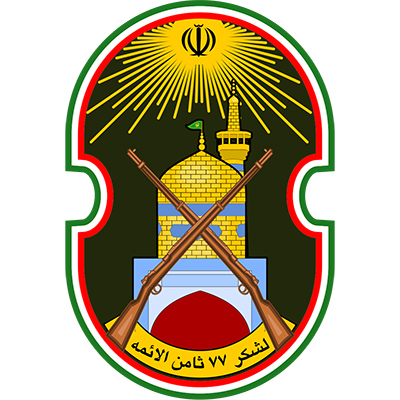Groups, Institutions, Organiza
The 77th Khorasan Division
Mohsen Shir-Muhammad
96 دورہ
The 77th Khorasan Division is a unit of the Islamic Republic of Iran Army based in northeastern Iran, which took part in the Iran–Iraq War. This division has a long historical background. In 1921, a military order to create a unified army resulted in the formation of the Eastern Division in Mashhad.[1] Over time, it expanded and was stationed in Khorasan Province with three organized brigades under the name “77th Khorasan Division”. Before the Islamic Revolution, the commander of this division was considered one of the three most influential figures in the region. Among the missions it participated in before the Revolution were CENTO military exercises, the Dhofar War, peacekeeping deployments in Vietnam and Palestine, and relief operations following the 1978 earthquake in Tabas.
After the Islamic Revolution and with the emergence of domestic unrest, the division was deployed to Turkmen Sahra and Kurdistan.[2]
With the start of the Iran–Iraq War, the units of the 77th Division were dispatched to Khuzestan and engaged Iraqi forces in the western areas of Dezful and Ahvaz.[3] In 1980, following the siege of Abadan, the 153rd Battalion of the 77th Division was sent to the area by sea using hovercraft and helicopters.[4] On October 31, it engaged Iraqi forces in the Zolfaqari area and helped prevent the fall of Abadan.[5]
In 1980, the 77th Division was placed in command of the Abadan–Khorramshahr region and began planning for breaking the siege of Abadan.[6] Under the plan, later known as Operation Thamen al-Aemmah (as), the 1st, 2nd, and 3rd brigades of the 77th Division, along with Islamic Revolutionary Guard Corps (IRGC) units, were deployed to liberate occupied areas east of the Karun River.[7]
On September 27, 1981, Operation Thamen al-Aemmah (as) began. The 1st Brigade engaged enemy forces in the Zolfaqari axis, while the 2nd Brigade attacked from Fayyaziyeh and the 3rd from Darkhovein. After two days, Iranians pushed back the enemy from the eastern side of the Karun and broke the siege of Abadan. At the end of the operation, the captured Iraqi soldiers marched in front of high-ranking Iranian military commanders, and Colonel Seyyed Shahab al-Din Javadi, the division’s commander, made a speech in Arabic to the prisoners.[8] After this success, the division became known as the “Victorious Thamen al-Aemmah (as) Division”.[9]
The 77th Division also participated in Operation Fath al-Mubin, during which Abu Salibi Khat Hill and the radar station were captured by Iranians.[10] At the beginning of the operation on March 22, 1982, the division’s 3rd Brigade engaged Iraqi forces.[11] After two days, 150 square kilometers of Iranian territory—from Ain Khosh to Fakkeh—were liberated.[12]
All three brigades of the 77th Division also took part in the fourth phase of Operation Beit al-Muqaddas under the command of Fajr Headquarters. Their mission was to defend the Pol-e Nou and prevent the retreat of enemy forces from Khorramshahr.[13]
In mid-1982, three brigades of the 77th Division participated in Operation Ramazan, which was carried out in the southwestern border area of Khuzestan under the command of the Fajr Headquarters.[14]
The division also took part in Operation Valfajr 1 (April 1983), conducted in the Fakkeh region, and Operation Valfajr 2 (July 1983) in northwestern Iran, which led to the capture of Iraq’s Haj Omran Garrison.[15] Moreover, the 1st, 2nd, and 3rd brigades of the 77th Division took part in Operation Kheibar (February 1984), which resulted in the seizure of Majnoon Island. The division was once again deployed to the same region during Operation Badr in March 1985.[16]
The 1st Brigade of the 77th Division participated in operations Qader 1 and 2 in the western region of Oshnavieh in July and September 1985. Later, in August 1987, it joined Operation Nasr 6 in the Meimak Heights—a mission that lasted eight days with several Army units involved.[17]
During the Iran-Iraq War, due to the Soviet presence in Afghanistan and the resulting threat to Iran’s eastern borders, the 4th Brigade of the 77th Division was established to deal with this threat.[18]
Colonel Seyyed Shahab al-Din Javadi, Brigadier General Azim Azgami, Colonel Manouchehr Dezhkam, and Colonel Ali Bakhshi Nikfard were the commanders of the 77th Division during the war.[19] 2300 members of the division were martyred, 15949 were wounded, and 2865 were taken prisoner of war.[20]
Most of the 77th Khorasan Division forces remained in southern and southwestern Iran for several years after the war, taking part in missions to secure the borders and clear minefields. In late 1992, when the Rajat Plan was implemented, the division’s units returned to their home region. Also, in mid-1998, with the rise of the Taliban in Afghanistan and growing insecurity in the east, some units of the division were deployed to the border to ensure border security and fight against drug smuggling.[21]
In 2002, the 4th Brigade was separated from the 77th Division and formed the 38th Torbat-e Jam Armored Brigade. Later, as part of the Samen Plan, the 277th Quchan Brigade, 377th Mashhad Brigade, and 177th Torbat-e Heydarieh Brigade became independent. The 77th Division Headquarters now oversees these three brigades.[22] Currently, Brigadier General Abdolrahman Sasanian is the commander of the 77th Khorasan Division.[23]
[1] Raminnejad, Ramin, Tarikh-e Lashkar-e Khorasan (The History of Khorasan Division), Vol. 2, Mashhad, Ahang-e Qalam, 1391, p. 13.
[2] Akbari, Hamid-Reza, Hashtomin Maabar-e Aseman (The Eight Passage to the Sky), Mahnama-ye Saff, No. 439, Dey 1396, p. 61.
[3] Raminnejad, Ramin, Ibid., Pp. 40, 44, 45.
[4] Shir-Muhammad, Mohsen, Barfaraz Darya-ha – Negahi be Tarikh-e Havadarya va Hamaase-ye Eskadaran-ha-ye Havanav, Balgard va Bal Sabet dar Jang-e Tahmili (Above the Seas – A Glimpse into the History of the Naval Air Force and the Epic of Hovercraft, Helicopter and Fixed-Wing Squadrons in the Imposed War), Tehran, Daftar-e Pazhuhesh-haye Nazari va Motaleat-e Rahbordi-ye Niru-ye Daryayi, 1400, p. 148.
[5] Sarvari, Rouhollah and Abolqasem Javdani, Amaliyat-e Thamen al-Aemmah (as) (Operation Thamen al-Aemmah (as)), Tehran, AJA, 1390, Pp. 69–70.
[6] Ibid., Pp. 88–89.
[7] Markaz-e Motaleat va Tahqiqat-e Jang, Nabard-haye Sharq-e Karoun be Revayat-e Farmandehan (The Battles of East Karun as Narrated by Commanders), Tehran, Markaz-e Motaleat va Tahqiqat-e Jang-e Sepah-e Pasdaran, 1379, 1st ed., p. 176.
[8] Jafari, Mojtaba, Atlas-e Nabard-haye Mandegar (Atlas of Lasting Battles), Tehran, Soore Sabz, 1393, 35th ed., p. 64.
[9] Akbari, Hamid-Reza, Ibid., p. 60.
[10] Hussaini, Seyyed Yaqoub va Digaran, Naqshe Artesh-e Jomhouri-ye Eslami-ye Iran dar Hasht Sal-e Defa Muqaddas – Nabard-haye Gharb-e Dezful (The Role of the Islamic Republic of Iran Army in the Eight-Year Sacred Defense – Battles in Western Dezful), Vol. 1, Tehran, Sazman-e Aqidati-Siyasi Artesh, 1372, Pp. 215–216.
[11] Ibid., p. 220.
[12] Jafari, Mojtaba, Ibid., p. 74.
[13] Doroudian, Muhammad, Seyri dar Jang-e Iran va Araq – Az Khuninshahr ta Khorramshahr (A Study of the Iran–Iraq War – From Khuninshahr to Khorramshahr), Vol. 1, Tehran, Markaz-e Motaleat va Tahqiqat-e Jang-e Sepah-e Pasdaran, 4th rd., 1377, Pp. 155–158.
[14] Hussaini, Seyyed Yaqoub, Amaliyat-e Ramazan (Operation Ramazan), Tehran, Iran Sabz, 1392, p. 85.
[15] Raminnejad, Ramin, Ibid., Pp. 130–131.
[16] Ibid., Pp. 136, 138.
[17] Ibid., Pp. 143–144, 158.
[18] Akbari, Hamid-Reza, Ibid., p. 62.
[19] Raminnejad, Ramin, Ibid., p. 210.
[20] Ibid., Pp. 173, 176, 178.
[21] Akbari, Hamid-Reza, Yegan-e Tank-e Moqtader dar Moallefe-haye Nezami (The Powerful Tank Unit in Military Components), Mahnama-ye Saff, No. 442, Farvardin va Ordibehesht 1397, p. 44.
[22] Akbari, Hamid-Reza, Motaharek va Hojoomi (Moving and Offensive), Mahnama-ye Saff, No. 448, Aban 1397, p. 56; Akbari, Hamid-Reza, Yegan-e Tank-e Moqtader dar Moallefe-haye Nezami Nezami (The Powerful Tank Unit in Military Components), p. 44; Raminnejad, Ramin, Ibid., p. 62.
[23] Shabestan Khabargozari-ye Shabestan (Shabestan News Agency), 27 Esfand 1397, www.shabestan.ir/detail/News/774296





